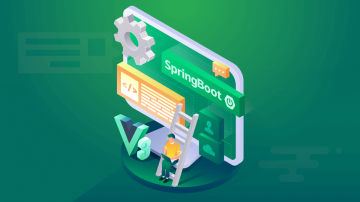Spring Boot 微服务教程介绍了如何使用 Spring Boot 框架快速搭建微服务应用,包括项目初始化、服务注册与发现、服务间通信等内容。文章详细讲解了从创建项目到部署的全过程,并提供了丰富的示例和配置说明。通过本教程,初学者可以快速入门 Spring Boot 微服务开发。
Spring Boot 简介什么是Spring Boot
Spring Boot 是一个基于 Spring 框架构建的开源微服务框架,它旨在简化 Spring 应用的初始搭建以及开发、简化基于 Spring 的基础设施的集成。Spring Boot 提供了自动配置功能,使得搭建一个简单的 Spring 应用程序变得非常快速,几乎不需要编写任何 XML 或者只需要很少的代码。
Spring Boot 的优势
- 快速启动:Spring Boot 提供了自动配置功能,使得搭建一个简单的 Spring 应用程序变得非常快速,无需进行大量的配置。
- 无需 XML 配置:大部分情况下,Spring Boot 应用程序不需要配置 XML 文件,很多配置都可以通过注解和 Java 配置类来完成。
- 嵌入式容器:Spring Boot 可以内嵌 Tomcat、Jetty、Undertow 等 Servlet 容器,提供了运行应用程序的内置支持。
- 依赖管理和版本控制:Spring Boot 使用约定优于配置的原则,提供了大量依赖库的默认版本,减少了管理这些依赖的复杂性。
- 快速开发:Spring Boot 提供了丰富的自动化配置和库支持,可以快速开发功能丰富的应用。
Spring Boot 项目结构
一个典型的 Spring Boot 项目结构如下:
my-spring-boot-app/
├── src/
│ ├── main/
│ │ ├── java/
│ │ │ └── com/
│ │ │ └── example/
│ │ │ └── myapp/
│ │ │ ├── Application.java
│ │ │ └── controller/
│ │ │ └── HelloController.java
│ │ └── resources/
│ │ └── application.properties
│ └── test/
│ └── java/
│ └── com/
│ └── example/
│ └── myapp/
│ └── MyApplicationTests.java
└── pom.xmlApplication.java:通常是 Spring Boot 应用程序的入口点,包含main方法,启动应用程序。controller目录:包含处理 HTTP 请求的控制器类。application.properties:包含应用的配置项,比如端口号、数据库连接等。pom.xml:项目依赖管理文件。
使用 Spring Initializr 创建项目
Spring Initializr 是一个可以在线创建 Spring Boot 项目的工具,它简化了项目初始化过程。以下是使用 Spring Initializr 创建项目的步骤:
- 访问 Spring Initializr。
- 选择项目类型:Maven 或 Gradle。
- 选择语言:Java。
- 选择 Java 版本。
- 选择依赖:可以选择 REST、Web、Thymeleaf、JPA 等。
- 选择项目组名和项目名。
- 点击 "Generate" 按钮,下载项目压缩包。
- 解压压缩包,在 IDE 中打开项目。
配置 pom.xml 文件
在 Spring Boot 项目中,pom.xml 文件用于管理项目的依赖和构建配置。以下是一个基本的 pom.xml 文件配置:
<project xmlns="http://maven.apache.org/POM/4.0.0" xmlns:xsi="http://www.w3.org/2001/XMLSchema-instance"
xsi:schemaLocation="http://maven.apache.org/POM/4.0.0 http://maven.apache.org/xsd/maven-4.0.0.xsd">
<modelVersion>4.0.0</modelVersion>
<groupId>com.example</groupId>
<artifactId>my-spring-boot-app</artifactId>
<version>0.0.1-SNAPSHOT</version>
<parent>
<groupId>org.springframework.boot</groupId>
<artifactId>spring-boot-starter-parent</artifactId>
<version>2.3.4.RELEASE</version>
</parent>
<dependencies>
<dependency>
<groupId>org.springframework.boot</groupId>
<artifactId>spring-boot-starter-web</artifactId>
</dependency>
<dependency>
<groupId>org.springframework.boot</groupId>
<artifactId>spring-boot-starter-test</artifactId>
<scope>test</scope>
</dependency>
</dependencies>
<build>
<plugins>
<plugin>
<groupId>org.springframework.boot</groupId>
<artifactId>spring-boot-maven-plugin</artifactId>
</plugin>
</plugins>
</build>
</project>创建第一个 Spring Boot 应用
创建一个简单的 Spring Boot 应用程序,包含一个控制器类 HelloController。
- 创建
Application.java文件:
package com.example.myapp;
import org.springframework.boot.SpringApplication;
import org.springframework.boot.autoconfigure.SpringBootApplication;
@SpringBootApplication
public class Application {
public static void main(String[] args) {
SpringApplication.run(Application.class, args);
}
}- 创建
HelloController.java文件:
package com.example.myapp.controller;
import org.springframework.web.bind.annotation.GetMapping;
import org.springframework.web.bind.annotation.RequestMapping;
import org.springframework.web.bind.annotation.RestController;
@RestController
@RequestMapping("/hello")
public class HelloController {
@GetMapping
public String sayHello() {
return "Hello, World!";
}
}- 启动应用:
运行 Application.java 中的 main 方法,应用会在默认端口 8080 上启动。浏览器访问 http://localhost:8080/hello,可以看到“Hello, World!”的响应。
配置 application.properties 文件
在 src/main/resources 目录下创建 application.properties 文件,用于设置应用程序的配置项,如端口号等:
server.port=8080服务发现与注册
微服务架构中,各个服务需要互相通信。为了实现服务发现和注册,可以使用像 Eureka 这样的服务注册中心。服务注册中心负责维护服务实例的列表,并提供服务发现的方法。
使用 Spring Cloud Eureka 搭建服务注册中心
- 在
pom.xml文件中添加 Eureka 依赖:
<dependency>
<groupId>org.springframework.cloud</groupId>
<artifactId>spring-cloud-starter-netflix-eureka-server</artifactId>
</dependency>- 配置 Eureka 服务注册中心。在
application.properties文件中添加以下配置:
spring.application.name=eureka-server
server.port=8761
eureka.client.register-with-eureka=false
eureka.client.fetch-registry=false
eureka.server.enable-self-preservation=false- 创建
EurekaServerApplication.java文件:
package com.example.myapp;
import org.springframework.boot.SpringApplication;
import org.springframework.boot.autoconfigure.SpringBootApplication;
import org.springframework.cloud.netflix.eureka.server.EnableEurekaServer;
@SpringBootApplication
@EnableEurekaServer
public class EurekaServerApplication {
public static void main(String[] args) {
SpringApplication.run(EurekaServerApplication.class, args);
}
}- 启动 Eureka 服务注册中心:运行
EurekaServerApplication.java中的main方法。
创建微服务实例并注册到 Eureka
- 在
pom.xml文件中添加 Eureka 客户端依赖:
<dependency>
<groupId>org.springframework.cloud</groupId>
<artifactId>spring-cloud-starter-netflix-eureka-client</artifactId>
</dependency>- 在
application.properties文件中添加 Eureka 客户端配置:
spring.application.name=hello-service
server.port=8082
eureka.client.service-url.defaultZone=http://localhost:8761/eureka/- 修改
Application.java文件,添加@EnableDiscoveryClient注解:
package com.example.myapp;
import org.springframework.boot.SpringApplication;
import org.springframework.boot.autoconfigure.SpringBootApplication;
import org.springframework.cloud.client.discovery.EnableDiscoveryClient;
@SpringBootApplication
@EnableDiscoveryClient
public class Application {
public static void main(String[] args) {
SpringApplication.run(Application.class, args);
}
}- 重新启动
Application.java中的main方法,服务会自动注册到 Eureka 服务注册中心。
RESTful 服务间通信
在微服务架构中,服务间通信通常使用 RESTful API。RESTful API 通过 HTTP 方法(GET、POST、PUT、DELETE 等)来操作资源。
使用 Feign 进行服务调用
Feign 是一个声明式的 Web 服务客户端,它使得编写 Web 服务客户端变得更加简单。使用 Feign 可以声明式地调用服务,而不需要直接管理 HTTP 请求。
- 在
pom.xml文件中添加 Feign 依赖:
<dependency>
<groupId>org.springframework.cloud</groupId>
<artifactId>spring-cloud-starter-openfeign</artifactId>
</dependency>- 配置 Feign 客户端。在
application.properties文件中添加以下配置:
spring.application.name=service-consumer
server.port=8083
eureka.client.service-url.defaultZone=http://localhost:8761/eureka/- 创建 Feign 客户端接口:
package com.example.myapp.client;
import org.springframework.cloud.openfeign.FeignClient;
import org.springframework.web.bind.annotation.GetMapping;
@FeignClient(value = "hello-service", url = "http://localhost:8082")
public interface HelloClient {
@GetMapping("/hello")
String sayHello();
}- 创建服务消费者
HelloConsumer.java文件:
package com.example.myapp.consumer;
import com.example.myapp.client.HelloClient;
import org.springframework.beans.factory.annotation.Autowired;
import org.springframework.web.bind.annotation.GetMapping;
import org.springframework.web.bind.annotation.RestController;
@RestController
public class HelloConsumer {
@Autowired
private HelloClient helloClient;
@GetMapping("/hello-consumer")
public String sayHello() {
return helloClient.sayHello();
}
}- 重新启动
Application.java中的main方法。
实现服务容错与熔断
在微服务架构中,服务容错和熔断是必要的,以确保系统的稳定性和可用性。Spring Cloud 提供了 Hystrix 和 Resilience4j 等工具来实现服务容错和熔断。
- 在
pom.xml文件中添加 Hystrix 依赖:
<dependency>
<groupId>org.springframework.cloud</groupId>
<artifactId>spring-cloud-starter-netflix-hystrix</artifactId>
</dependency>- 在
HelloClient.java接口上添加容错配置:
package com.example.myapp.client;
import org.springframework.cloud.openfeign.FeignClient;
import org.springframework.cloud.openfeign.FeignClientConfiguration;
import org.springframework.web.bind.annotation.GetMapping;
@FeignClient(value = "hello-service", url = "http://localhost:8082",
configuration = FeignClientConfiguration.class,
fallback = HelloClientFallback.class)
public interface HelloClient {
@GetMapping("/hello")
String sayHello();
}- 创建容错的 fallback 类
HelloClientFallback.java:
package com.example.myapp.client;
import org.springframework.stereotype.Component;
@Component
public class HelloClientFallback implements HelloClient {
@Override
public String sayHello() {
return "Hello, Service is down!";
}
}打包 Spring Boot 应用
- 使用 Maven 打包命令:
mvn clean package这将生成包含所有依赖项的可执行 jar 文件,通常位于 target 目录下。
部署到云平台(如 Docker、Kubernetes)
使用 Docker 部署
- 创建
Dockerfile文件:
FROM openjdk:11-jre-slim
VOLUME /tmp
COPY target/my-spring-boot-app.jar my-spring-boot-app.jar
EXPOSE 8080
ENTRYPOINT ["java","-Djava.security.egd=file:/dev/./urandom","-jar","/my-spring-boot-app.jar"]- 构建 Docker 镜像:
docker build -t my-spring-boot-app .- 运行 Docker 容器:
docker run -p 8080:8080 my-spring-boot-app使用 Kubernetes 部署
- 创建
deployment.yaml文件:
apiVersion: apps/v1
kind: Deployment
metadata:
name: my-spring-boot-app
spec:
replicas: 1
selector:
matchLabels:
app: my-spring-boot-app
template:
metadata:
labels:
app: my-spring-boot-app
spec:
containers:
- name: my-spring-boot-app
image: myregistry.io/my-spring-boot-app
ports:
- containerPort: 8080- 创建
service.yaml文件:
apiVersion: v1
kind: Service
metadata:
name: my-spring-boot-app-service
spec:
selector:
app: my-spring-boot-app
ports:
- protocol: TCP
port: 80
targetPort: 8080
type: LoadBalancer- 应用部署文件:
kubectl apply -f deployment.yaml
kubectl apply -f service.yaml监控与日志管理
使用 Prometheus 监控
- 添加 Prometheus 依赖:
<dependency>
<groupId>org.springframework.boot</groupId>
<artifactId>spring-boot-starter-actuator</artifactId>
</dependency>
<dependency>
<groupId>io.prometheus</groupId>
<artifactId>simpleclient</artifactId>
</dependency>
<dependency>
<groupId>io.prometheus</groupId>
<artifactId>simpleclient_springboot</artifactId>
</dependency>- 配置
application.properties:
management.endpoints.web.exposure.include=*
management.endpoints.web.base-path=/actuator使用 Logback 日志管理
- 配置
logback.xml文件:
<configuration>
<appender name="STDOUT" class="ch.qos.logback.core.ConsoleAppender">
<encoder>
<pattern>%d{yyyy-MM-dd HH:mm:ss} - %msg%n</pattern>
</encoder>
</appender>
<root level="info">
<appender-ref ref="STDOUT" />
</root>
</configuration>构建一个简单的微服务系统
构建一个简单的微服务系统,包含两个服务:一个服务提供者(HelloService)和一个服务消费者(HelloConsumer)。
服务提供者(HelloService)
-
搭建服务提供者项目。
- 创建
HelloController.java文件:
package com.example.myservice.controller;
import org.springframework.web.bind.annotation.GetMapping;
import org.springframework.web.bind.annotation.RequestMapping;
import org.springframework.web.bind.annotation.RestController;
@RestController
@RequestMapping("/hello")
public class HelloController {
@GetMapping
public String sayHello() {
return "Hello, Service!";
}
}- 修改
application.properties文件:
spring.application.name=hello-service
server.port=8082
eureka.client.service-url.defaultZone=http://localhost:8761/eureka/- 添加 Eureka 客户端依赖:
<dependency>
<groupId>org.springframework.cloud</groupId>
<artifactId>spring-cloud-starter-netflix-eureka-client</artifactId>
</dependency>服务消费者(HelloConsumer)
-
搭建服务消费者项目。
- 创建
HelloClient.java文件:
package com.example.myservice.client;
import org.springframework.cloud.openfeign.FeignClient;
import org.springframework.web.bind.annotation.GetMapping;
@FeignClient(value = "hello-service", url = "http://localhost:8082")
public interface HelloClient {
@GetMapping("/hello")
String sayHello();
}- 创建
HelloConsumer.java文件:
package com.example.myservice.consumer;
import com.example.myservice.client.HelloClient;
import org.springframework.beans.factory.annotation.Autowired;
import org.springframework.web.bind.annotation.GetMapping;
import org.springframework.web.bind.annotation.RestController;
@RestController
public class HelloConsumer {
@Autowired
private HelloClient helloClient;
@GetMapping("/hello-consumer")
public String sayHello() {
return helloClient.sayHello();
}
}- 修改
application.properties文件:
spring.application.name=service-consumer
server.port=8083
eureka.client.service-url.defaultZone=http://localhost:8761/eureka/- 添加 Feign 依赖:
<dependency>
<groupId>org.springframework.cloud</groupId>
<artifactId>spring-cloud-starter-openfeign</artifactId>
</dependency>部署并测试
- 启动 Eureka 服务注册中心。
- 启动
HelloService服务提供者。 - 启动
HelloConsumer服务消费者。 - 访问
http://localhost:8083/hello-consumer,可以看到 "Hello, Service!" 的响应。
解决常见问题与调试技巧
问题:服务注册失败
原因:Eureka 客户端配置错误,无法连接到 Eureka 服务注册中心。
解决:检查 application.properties 文件中的 Eureka 客户端配置,确保 eureka.client.service-url.defaultZone 设置正确。
问题:Feign 调用失败
原因:Feign 客户端配置错误,或服务提供者不可用。
解决:检查 Feign 客户端接口的 @FeignClient 注解配置,确保 value 和 url 值正确。此外,确保服务提供者正常运行。
调试技巧
- 日志:使用日志记录调试信息,比如使用 Logback 或 Log4j,并在控制台查看日志输出。
- IDE 调试工具:使用 IntelliJ IDEA 或 Eclipse 的调试工具,设置断点进行调试。
- Postman:使用 Postman 测试 RESTful 服务接口,验证服务是否正常工作。
- 监控工具:使用 Prometheus、Grafana 等监控工具,监控服务状态和性能。
通过以上步骤,可以构建和调试一个简单的微服务系统,掌握服务注册、服务发现、服务调用等基本操作。

 随时随地看视频
随时随地看视频




